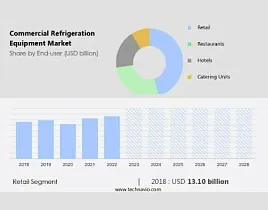
U.S. and Canada refrigerated trucking market size reach revenues of USD 12 billion by 2020, growing at a CAGR of 4% during 2020-2025.
U.S. and Canada Refrigerated Trucking Market Size, Share, & Trends Analysis Report by Service (FTL and LTL), Temperature Compartment (Single and Multi), End-users (food, pharmaceuticals, and others), Vehicles (Trailers and Vans), and Geography (the United States and Canada) Industry Analysis Report, Regional Outlook, Market Trends, Competitive Landscape, Share, Growth Potential & Forecast, 2020 – 2025.
The US and Canada refrigerated trucking market size will reach USD 12 billion by 2025, growing at a CAGR of 4% during 2020-2025. The challenge of perishability and the need to preserve food and non-food categories at optimal temperatures to prevent spoilage are the major growth enablers for the refrigerated trucking market in the US and Canada. The growth in refrigerated warehouse capacities in the US and Canada has a positive impact on the refrigerated logistics market. Being geographically vast countries, the US and Canada need to have refrigerated truck transport and trailers for long haul transportation to avoid food spoilage, thereby influencing the market.
Pharmaceutical products need to be maintained at a precise temperature to maintain their efficiency. Time and temperature are two vital factors to be taken into consideration when transporting medicines. The pharmaceutical market in the US and Canada continues to grow at a steady rate of YOY. Therefore, pharma products are mandatory to be transported in temperature-controlled trucks becomes a driving force for the refrigerated trucking market.
The refrigerated trucking market by less than truckload (LTL) is growing at a steady pace driven by end-users such as F&B and pharma industry. The (LTL) industry in North America is composed of numerous vendors. The growth of e-commerce has a high positive impact on the overall LTL industry. However, dry freight has a higher share compared to refrigerated freight. LTL carriers commonly employ covered or enclosed van trailers. The usage of LTL refrigerated trailers is less compared to dry freight LTL carriers. Online retail is a major driver for the LTL segment.
Capacity constraints on certain lanes are expected to increase rates in the full truckload (FTL) sector. The rate increase is expected to be more in FTL than LTL on account of long routers covered and the high usage of diesel. The FTL industry savings are more than LTL on account of less number of spoke and hub stations. Also, the long-term contract of the FTL industry makes it more operationally stable than LTL. However, the capacity constraint has forced shippers to look for a capacity guarantee to beat challenging market conditions.
The single temperature and multi-temperature logistics segments supplement each other’s growth. Currently, single temperature refrigerated trucking services dominate the industry. However, the growth of multi-temperature refrigerated trucking services has been higher. Reduced weight and improved fuel economy are the characteristics of single-temperature truck trailers. The demand for multi-temperature service has high adoption in the F&B industry. The major growth enabler is due to the growth in online food and fresh produce delivery services. The increase in usage of a multi-temperature refrigeration system has given rise to operational efficiency.
The food & beverage industry dominates the reefer truck market. The logistics cost in the food industry accounts for 7−10% of the total product cost. The increasing number of quick-service restaurants and retail outlets has fueled food consumption, which has increased the demand for chilled and frozen food and beverages. Foods that are expected to see high demand for packaging include organic foods, dairy, and meat. Scaling up of tier 2 brands in the US food industry is expected to bring high volumes, while larger food corporations will drive the steady need for refrigerated transportation.
The U.S. dominates the North American healthcare and pharmaceutical industry. It holds many of the leading global pharmaceutical companies. The US alone controls about 45% of the global pharmaceutical industry. The US has the largest market in biopharmaceuticals that accounts for one-third of the global market. Transporting pharma products requires proper temperature controls as several drugs are temperature-sensitive and must be delivered on time. Therefore, to maintain the quality of medicines and drugs, pharma companies rely on temperature-controlled transporting.
While refrigerated trailers reduce operating expenses by reducing fuel and/or power consumption, they are complex to manage. The availability of long-haul truck drivers is a major concern both in the U.S. and Canada. The FTL and LTL segment use trailers for delivering cargo. However, the utilization of vans is limited to the LTL segment. Since the FTL demand is currently high, and also the regional LTL demand is growing, the usage of the trailer is growing.
The vans market is expected to witness steady growth during the forecast period. Online grocery, food delivery, and beverages are the major end-user of this segment. A majority of the last mile deliveries and some regional deliveries of cargo takes place through refrigerated vans.
Multi segmented refrigerated trucks can maintain different optimum temperature levels. Multiple temperature trucks are more particularly used for the retail application, where temperature-controlled models are required to replenish store stock with relatively small quantities from regional distribution centers.
Canada stands out to be on top as the largest country both in the production and consumption of food products and beverages. The agriculture and food and beverage processing industries in Canada contributes around 6.8% toward GDP annually. Quebec and Ontario hold leading two positions in agriculture and food and beverage processing industries.
The U.S. and Canada refrigerated trucking industry is large, fragmented, and highly competitive with thousands of FTL and LTL carriers. No single vendor dominates the market. The three major factors on which the competition is dependent include – tariff, capacity, and customer service. The competitive factors change as and when the market conditions change. For instance, in the low demand market scenario, the tariff for hire refrigerated trucking company becomes significant, while in the times of high customer demand, the capacity and service quality make become more vital.



